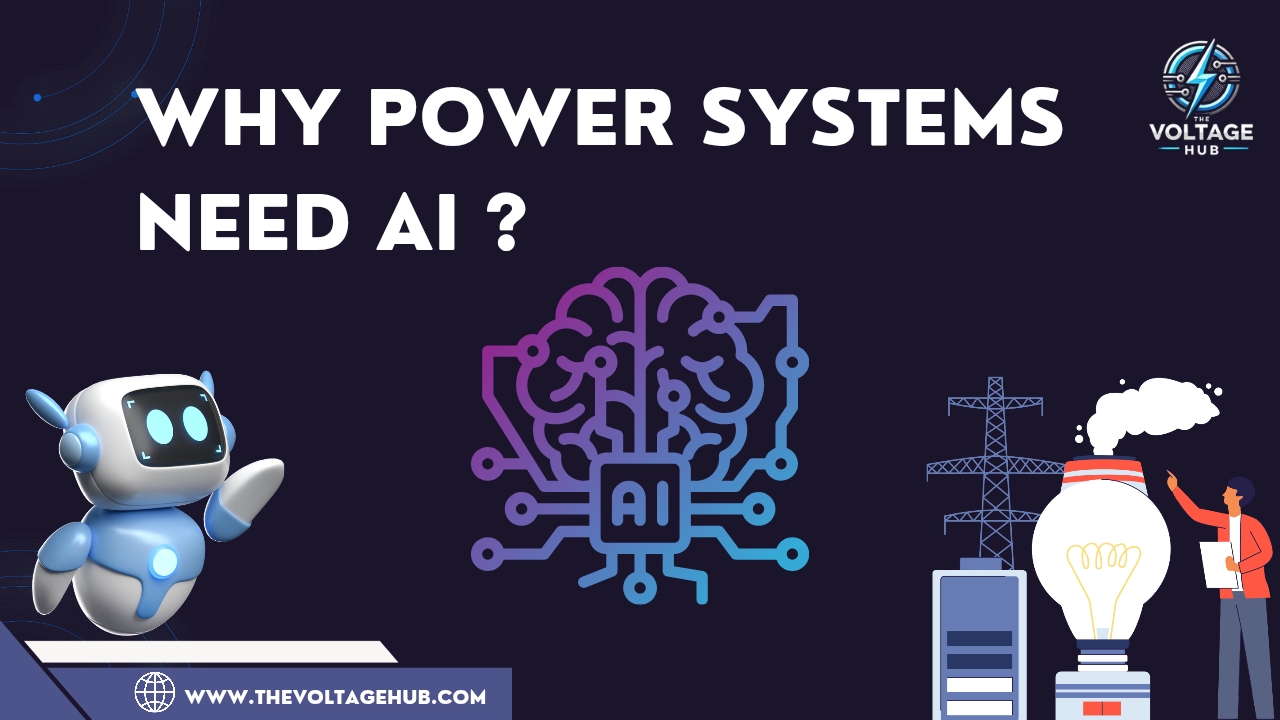Table Of Content
- 1 1. Why Power Systems Need AI to Manage Increased Complexity
- 2 2. Key Challenges Faced by Today’s Power System
- 3 3. Opportunities in AI Application within Power System
- 4 4. Some Real-World Implementations of AI in the Power Systems
- 5 5. Challenges in AI Implementation
- 6 6. Future of AI in Power Systems
- 7 Conclusion
In the last few years, why power systems need AI has become a crucial topic of discussion as artificial intelligence (AI) finds substantial application in enhancing modern power grids. The power system, the backbone of modern civilization, transmits electricity from generating plants to consumers. However, the increasing complexity and demand pose significant challenges. Why power systems need AI is clear when considering how AI solutions offer unparalleled efficiency, reliability, and sustainability improvements. This article explores the challenges in power systems and how AI addresses them.
1. Why Power Systems Need AI to Manage Increased Complexity
The power systems are changing at a rapid pace due to many aspects, which include:
- Greater need for electricity induced by growth in urbanization and expansion at the level of industry.
- Integration of renewable energy sources-solar and wind-is characterized by periodic generation, therefore less predictable.
- Distributed energy resources (DERs) such as microgrids and energy storage systems.
These advancements add complexity to grid operations. Traditional approaches struggle with dynamic conditions, highlighting why power systems need AI to provide smarter, adaptive solutions.
2. Key Challenges Faced by Today’s Power System
a. Grid Stability and Reliability:
One of the major challenges is to keep the power supply stable and reliable. This variability further increases with the integration of renewable energy.
Challenges:
-
Fluctuating power supply from renewables.
-
Frequency and voltage stability problems.
-
Outages that could disrupt key services.
AI Solutions: AI algorithms can predict where supply and demand will fluctuate by looking at machine-learning models. Also, predictive maintenance through the action of AI helps bring about the evaluation of equipment failure and reduces downtime with prior identification rather than actual downfall.
b. Energy Demand Forecasting:
Energy demand must be forecasted correctly for a better balancing of demand and supply.
Challenges:
- Sudden changes in the consumption pattern.
- Limited accuracy of traditional models.
AI Solutions: AI uses historical data, weather patterns, and real-time information for precise forecasting. Techniques like deep learning and neural networks offer insights beyond the scope of traditional models, demonstrating why power systems need AI for better demand-supply balance.
c. Integrating Renewable Energies:
While renewable sources of energy are clean, their utilization is beset with a lot of unpredictability because they are tied to weather conditions.
Challenges:
- Variability and uncertainty in energy output.
- Congestion in the grid due to uneven distribution.
AI Solutions: AI-powered energy management systems optimize renewable energies integration, through generation pattern forecasting and storage systems management. Reinforcement learning models are helpful in improving grid flexibility.
d. Cybersecurity Threats:
This is because, with increased digitization, power systems become vulnerable to cyber-attacks.
Challenges:
- Data breaches and unauthorized access.
- Threats to critical infrastructure.
AI Solutions: AI-based cybersecurity tools detect network anomalies and respond to threats in real-time, providing proactive defense and reinforcing why power systems need AI for security.
3. Opportunities in AI Application within Power System
a. Intelligent Grid Management
AI enables smart grid technologies that can adapt on a real-time basis to different conditions.
Benefits:
- Automated grid operations control.
- Real-time fault detection and isolation.
Example:
AI-powered self-healing grids can even detect faults and reroute power to decrease the number and duration of grid outages in operation.
b. Predictive Maintenance
AI helps in optimizing such schedules for better performance through their predicted failures on various equipment.
Benefits:
- Reduced operational costs.
- Extended life of critical components.
Example:
These algorithms scan through sensor data emanating from transformers and generators to predict impending failures and suggest timely interventions.
c. Energy Efficiency Improved
AI technologies increase energy efficiency all the way along the power system.
Benefits:
- Optimized load management.
- Less waste of energy.
Example:
AI-powered demand response systems shift load during peak times, ultimately lowering costs while conserving energy.
d. Distributed Energy Resource Management
It is not an easy job to handle the decentralized power generation.
Benefits:
- Improved coordination among DERs.
- Improved grid resilience.
Example:
AI coordinates solar panels, batteries, and electric vehicles to optimize power distribution and storage.
4. Some Real-World Implementations of AI in the Power Systems
Case Study 1: DeepMind and Data Centers
It uses AIs from DeepMind to save energy in the data centers by running AI algorithms that optimize the cooling systems-a reduction of about 40%.
Case Study 2: Predictive Maintenance in Smart Grids
Utilities are deploying AI to analyze sensor data from smart grids, while predictive maintenance tools prevent equipment failures, further enhancing reliability and reducing downtime.
5. Challenges in AI Implementation
In addition, while such AI techniques and their advantages speak volumes for adoption, implementation AI in power systems comes with various challenges:
a. Data Quality and Availability
Most AI models are still requiring an immense volume of high-quality data, which can be impracticable in their obtainment.
b. High Implementation Costs
The development and deployment of AI solutions are extremely capital-intensive.
c. Regulatory and Ethical Concerns
AI applications should be designed to meet industry regulations and ethical standards.
6. Future of AI in Power Systems
AI in the future could pay much promise for transforming power systems:
- Advanced grid automation, such as AI-driven autonomous systems.
- AI-powered microgrids that enable local energy optimization are being developed.
- Blockchain-powered integration for secure energy transactions.
Conclusion
Why power systems need AI is no longer a question but a necessity. AI addresses critical challenges like grid stability, renewable energy integration, and cybersecurity. By leveraging AI technologies, power systems can become more resilient, efficient, and sustainable. The journey ahead requires continued innovation, collaboration, and investment to unlock AI’s full potential in powering the world of tomorrow.


